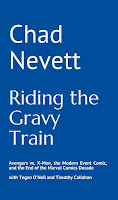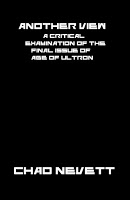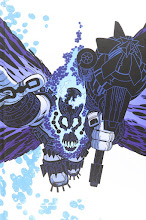Global Frequency #10 ("Superviolence"). Written by Warren Ellis. Drawn by Tomm Coker. Coloured by David Baron.
This post will be a bit different, because, unlike previous comics discussed, I have read the script to this issue, which you can download off of Warren Ellis's site (he pointed me in that direction in the comments to yesterday's post) and it makes a difference when looking at the art. The script and comic could be different in previous issues, but since I didn't have the scripts, I don't know.
Here, though, Coker's art definitely deviates from the script consistently throughout the issue. That's not meant to suggest that that's good or bad. Ellis has always been the sort of writer who acknowledges that, sometimes, what the writer calls for isn't what will look best -- something that's definitely true with action where the artist can do layouts and thumbnails and see that what looked good in the script doesn't work as effectively on a comics page. So, there is merit to the idea of the artist going off script a little at times, but Coker does it very consistently throughout the issue, using the script as a guide of the general action and character beats, adding and subtracting panels on pretty much every page. So, I want to look at where it works and where it doesn't. (Note, I don't mean to be on one side or the other, but being a writer myself, I'm naturally inclined to side with the writer's wishes. So bear that in mind. I want to show what works and what doesn't, so if I ever seem to cross that line into decrying Coker for daring to change what Ellis wrote, that's unintentional and a side-effect of my own personal bias.)
This issue has, probably, the simplest plot: Lionel Wellfare is a fucked up guy whose presence somewhere means that people will die. So, the Global Frequency sends the Frenchman to kill him. Both men use biofeedback to supress the pain of injuries and keep going -- basically, mind over body. It's one big, long fight sequence. Minimal dialogue, just two guys beating the shit out of one another.
First, the colouring. In issue eight, David Baron used the colours to heighten the mood, bathing secenes and locations in one colour as a cue to the reader. He does something similar here, but it doesn't work as effectively. The entire fight between Wellfare and the Frenchman is coloured with a pale, bright green. Aleph's room is a pale blue. Miranda Zero's location is yellow/orange. The exterior on one page is purple. Now, obviously, this isn't meant to be real, but I question the choice only because it goes against what we've seen in previous issues, particularly in Aleph's room. There have been some variations, but, for the most part, when we've see Aleph, if there is a colour of the light that dominates the space, it's green. We've seen instances where there is no dominant lighting and she's coloured in a straight-forward, realistic manner, but, if there is a dominant light, it's green. Switching to blue here seems odd. Why was that choice made? Is it because of the heavy use of green elsewhere? If so, why was green chosen? Green is the colour of life, so it relates to biofeedback possibly...? I don't know. The steady colour kind of levels the entire thing out, makes you focus on the movements of the characters more and blood is played off against green stronger than any other colour, so maybe that's it. The only problem then is that Baron doesn't go all of the way with the colouring: he still uses realistic skin tones and a darker red for the blood, so it doesn't contrast strongly. Is this meant to be the lighting inside the facility where they're fighting? I'm not a fan of the colouring of this issue.
For Coker's art, there are some choices he makes that I understand and think are effective, but others that I don't. One interesting choice is that, once the fight begins, every page has one panel that has a completely white background (one page has two). This panel is the main focal point of violence on the page usually. Almost like if you were to skim the book, all you need to do is pay attention to these panels. Having just quickly gone through the issue looking just at those panels, there is a progression. While most of the panels show a violent action, some just show a character getting up, struggling to stand, or something a little quieter to showcase the effects of the violence. It's probably the most effective and interesting thing Coker does in the issue, distilling each page down to one focal point. It's almost necessary in a book like this.
I mentioned that Coker deviates from the script quite a bit and I'd like to get into that... On the first page, there are some deviations, two that I want to highlight.
From the script:
Pic 1;
OPEN ON; ALEPH, in GF Central, looking at a screen that shows MIRANDA ZERO on videophone. Miranda is closing her eyes and rubbing her forehead in tired irritation.
ALEPH; LIONEL WELLFARE IS WORKING AGAIN, MS ZERO.
MIRANDA (ON SCREEN; WHY WON’T THAT BASTARD JUST DIE?
TITLES; “SUPERVIOLENCE”
In the actual panel, we see Aleph in the foreground, looking to the left of the panel, Miranda Zero on a series of screens in the background, just her face, sunglasses on, not showing the 'tired irritation' that Ellis calls for. Looking at the space allotted for the panel, I'm not sure if there's room to do what Ellis asks for -- but Coker also did the layout, so whose fault is that? I can understand the change, because Coker, when depicting Miranda Zero, seems to want to show her as cold and detached somewhat. In that regard, it's consistent with the rest of the issue. Later in the issue, on page thirteen, instead of giving us one panel of, "CUT TO: MIRANDA speaking into her phone, apparently at dinner with Ernst Blofeld," Coker extends it to three side views of Miranda in a car, the three speech balloons listed in the script separated to one per panel. I don't think this is an effective approach for the character since, while somewhat cold when there's a problem that needs solving, Miranda Zero is a caring, compassionate person deeply invested in protecting people. Here, she comes across as a businessperson. While there are elements of that coldness in Ellis's script (her sitting at an outdoor cafe, sipping champagne), there's also the idea that she was enjoying her day until this guy fucked it up, that the champagne was what she just happened to be drinking at the time. By eliminating that 'tired irritation,' Coker dehumanises Miranda, a choice that I don't think works.
One that does on that opening page is deviating from the script where Ellis calls for:
CUT TO; Miranda Zero, sitting at a street café table somewhere, in the sunshine, her GF phone propped up against the menu card – it’s this she’s speaking to Aleph on, videophone-mode. A waiter lowers a flute of champagne to her table.
Here, instead, Coker shows an above view of the cafe, umbrellas obsctructing our view of people. However, he slowly comes down to Miranda, revealing the details that Ellis called for in this panel in those ones (changing the menu card to a coffee cup). That's a clever instance of using details given on one panel to provide visuals for later panels well. He makes other small changes, but none that detract or devaite radically from Ellis's script.
In the fight, Coker makes a lot of changes, but keeps the general thrust of the fight, except in a few places. I like Coker's art here. It's sketchy and heavily shadowed, which obscures some of the visuals and, in one or two spots, I literally didn't understand what he was trying to communicate, but it's effective. His style lends itself to the brutality of the fight. By the end, both men look run down and you're surprised they can stand.
One thing that Ellis calls for in his script that doesn't show up in the comic is the use of x-ray panels to show how the damage we're seeing inflicted on the outside is mirrored on the inside. He calls for it twice:
[Page 8] Pic 3;
X-RAY SHOT: of the Frenchman’s hand coming down on the spine – in X-Ray, side-on view, we see Wellfare’s spine twisting into a kind of w-shape under the blow. It’s really not supposed to look like that.
[...]
[Page 18] Pic 4;
X-RAY SHOT; Of Wellfare’s torso. Intact, relatively.
Pic 5;
REPEAT PIC – except that suddenly all his ribs have snapped in two and his breastbone looks like a barcode it’s got so many cracks in it.
Coker doesn't depict these panels. On page eight, he shows the Frenchman punching Wellfare in the back, but without the x-ray effect. On page 18, he cuts those panels altogether, cutting the page down to two panels and changing the effect of the scene. Since Ellis doesn't call for the effect extensively, I can understand dropping it. It shows up twice and isn't essential to the understanding of what's going on. It's a cool visual trick. I'm not convinced that losing it on page 18 is the best choice since it does mean he reworks the scene with the chair quite a bit, streamlining it. In the script, the idea that Wellfare takes the first chair shot and laughs it off, while we see that, no, it did a lot of damage and the Frenchman exploits the wounded chest with a heavy kick is more interesting than Wellfare being taken down by the first chairshot. It loses an interesting bit of business.
In other places, Coker adds panels to show movement in more detail. When Wellfare initially encounters the Frenchman, Coker extends things where the Frenchman tosses a chair (I do like the callback later in the issue) and knocks Wellfare down. Ellis asks for:
Pic 1;
Wellfare staggers back, stunned, gun loose in his hand.
Pic 2;
Frenchman kicks the gun out of Wellfare’s hand, splintering his trigger finger as it snaps in the jerked-away trigger guard.
Coker draws Wellfare falling, gun out of his hand. The gun on the ground. Wellfare's hand picking up the gun with the same view as the second panel. Frenchman kicking Wellfare in the face, knocking him back, and the gun loose. The added panels make the scene a little more complex and a little more realistic. Those are the majority of changes he makes: adding or losing panels. Sometimes, it works, like here.
Sometimes, it doesn't. During the fight, the Frechman rips out Wellfare's right eye. Later, the Frenchman is shot and removes the bullet (a sequence which isn't exactly clear in the art). Ellis calls for:
Pic 5;
The Frenchman comes down on Wellfare and shoves the bullet into Wellfare’s blasted eyesocket.
FRENCHMAN; MY GIFT
PAGE SIXTEEN
Pic 1;
CLOSE-UP SHOT: Jagged bullet rubbing against dangling nerve fibers and ripped arteries…
Coker loses that second panel and it's not entirely clear in the issue what happened. He doesn't use the most effective perspective on the Frenchman inserting the bullet, opting for a side view on Wellfare's left side despite the empty eye socket being the right. Also, since the bullet is crumpled from being fired into the Frenchman, it just looks like a small piece of metal, no indication that it's the bullet from earlier, partly because the way that he drew the extraction wasn't 100% clear -- it's hard to see the extracted bullet. By losing the shot of the bullet in the socket, it loses some clarity. I suppose this is similar to the x-ray panels as Coker avoided going beyond the surface of the action.
I could continue to point out changes he made, calling some effective, some not. Overall, I think Coker's art is effective since it conveys the action strongly, only becoming confusing in a couple of places. I do think he made some questionable choices in the art that hurt it when you look at the script. If you've got the issue, give the script a look and see for yourself how the artist can interpret what the writer calls for.
Tomorrow: Jason Pearson and Global Frequency #11.






